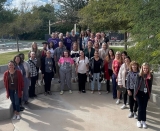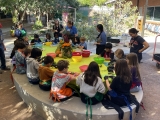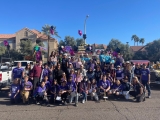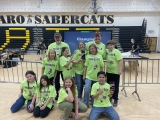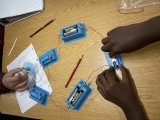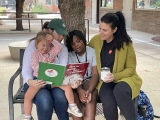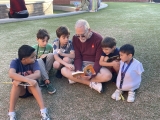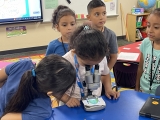-
Category 1
Selected in 2023
-
Grades: pre k - 8
School Setting: suburban
Town Population: 242,753
Student Enrollment: 360
Student Demographics:
Black/African American: 8%
Teacher/Student Ratio: 1:12
White/Caucasian: 34%
Hispanic: 50%
Hawaiian/Pacific Islander: 1%
Asian: 3%
Native American: 3%
Other: 1%
% Reduced Lunch: 56%
% ELL Learners: 15%
Founded: 1990 -
PRINCIPAL:
Kat Hughes -
CONTACT:
4330 N.62nd Street
Scottsdale, AZ 85251
480-484-7500
khughes@susd.org
Echo Canyon School
Scottsdale, AZ
We build relationships that are long-lasting and supportive of students’ social, emotional, and academic achievement.
- 1. Tell us about your school’s success.
- Echo Canyon School’s success is built upon a strong foundation of student and staff relationships. We are a small, preschool through eighth grade school which means a student could spend 11 years with us. During this time, our students spend two years with the same teacher in a looping model. In the second year of a loop, our teachers and students get back into the routine of school very quickly since procedures, routines, expectations and most classmates are the same. Because of the structures implemented at our school, we can build relationships that are long lasting and supportive of students’ social, emotional and academic achievement. Our small size allows staff members to know each student by name as well as strengths and challenges for individuals. We can provide specific targeted assistance to students to enrich or intervene to truly provide individualized and differentiated instruction to help students reach their full potential.
- 2. Talk about the greatest contributing factor(s) that promoted positive change in your school.
- In the 2016-17 school year, our school shifted from a multi-age environment to a schoolwide looping model. This change was one of the greatest contributing factors to our school’s success. Once we made the change to a looping model, our teachers were teaching one set of standards rather than trying to manage two sets of standards with two grade levels of students in a multi-age classroom. This increased focus on one set of standards with one grade level of students per year gave the teachers the opportunity to refine their instructional planning and delivery. With delivering more focused instruction, our student growth and achievement began to dramatically increase. When we returned to in person instruction after the pandemic, half of our students returned to their previous teacher because of the looping model. The relationship between the students and the staff allowed us to close the gap from virtual learning faster than many of our neighboring schools.
- 3. How has ESEA funding supported the school's success?
- Our ESEA funding has supported our school success through additional professional development, additional staffing, extended learning opportunities for students, family engagement activities and resources for staff and students. We are grateful that we can use our ESEA allocation to have additional staffing for a counselor for our elementary students. Our counselor is a critical member of our MTSS team and helps us to ensure students’ success across our K-8. Our ESEA funds help us to provide after-school tutoring and summer school opportunities to help us increase student growth and proficiency. Every grade level has family engagement activities in the evening that are designed to bring families together having fun while practicing academics. Our family engagement activities include math game night, science slime night and literacy events based upon children’s literature. We strategically use our funds through the year to maximize the impact of educational experiences for students.
- 4. What professional development activities were used to improve teaching and learning?
- Professional development for our staff has been a cornerstone of our school improvement efforts. We have a schoolwide focus on data analysis and our Multi-Tiered System of Supports for academics and behavior. Our teachers have been engaged in professional development that helps them understand meaningful data interpretation and how to determine next steps to differentiate and individualize instruction. We have a heavy emphasis on Tier 1, first best instruction. Our teachers have received professional development to increase the rigor through active student engagement, higher order questioning and critical thinking. We began AVID in our middle school and our middle school teachers have been using the AVID professional development learning in our AVID elective and core classes. Through mentoring and coaching, we can differentiate our professional development efforts for staff. We value and embrace lifelong learning opportunities to refine our practice.
- 5. Talk about the cultural shift leading up to your school's success.
- Over the past eight years, we have made great strides in implementing hands-on, experiential learning opportunities with an emphasis on our school gardens connected to state standards. Our staff has focused on creating lessons that engage learners with a variety of strategies that help to connect classroom learning to real-life experiences. Echo Canyon is home to an expansive school garden that includes native and edible plants, fruit trees, a National Wildlife Federation Certified Desert Tortoise habitat, a Monarch Butterfly Waystation and more. Students apply in class learning to the gardens in a variety of ways including managing our worm farm for vermiculture, composting and maintaining habitats. Our gardens help our students’ academic skills through real-world science and engineering, using natural phenomena to pique curiosity, process-based science notebooks to enhance the four domains of language arts and are used across the curriculum for hands-on interdisciplinary instruction.
- 6. How has community involvement strengthened your success?
- Our garden and Chef in the Garden program are our greatest initiatives to strengthen ties to the community. We have two great volunteers who help connect our school to community partnerships. Our gardens serve as the demonstration school for the Blue Watermelon Project. This partnership helps bring in our community members to help serve in our garden and local chefs to cook with our students. Community members volunteer to lead experiences in our gardens planting, harvesting and preparing what has been grown while our teachers connect the learning to the classroom. When our students work in the garden, they develop teamwork and cooperation, and practice negotiating who will do what task. They have rich opportunities to develop their problem-solving skills. The community is an integral part of making this and more happen with us. We could not accomplish our goals without the support of our community. Our partnerships increase every year and our students reap the benefits.
Stats
-
Category 1
Selected in 2023
-
Grades: pre k - 8
School Setting: suburban
Town Population: 242,753
Student Enrollment: 360
Student Demographics:
Black/African American: 8%
Teacher/Student Ratio: 1:12
White/Caucasian: 34%
Hispanic: 50%
Hawaiian/Pacific Islander: 1%
Asian: 3%
Native American: 3%
Other: 1%
% Reduced Lunch: 56%
% ELL Learners: 15%
Founded: 1990 -
PRINCIPAL:
Kat Hughes -
CONTACT:
4330 N.62nd Street
Scottsdale, AZ 85251
480-484-7500
khughes@susd.org


